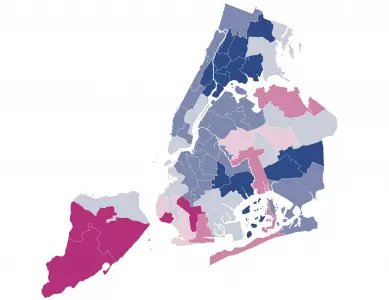How Your NYC Neighborhood Voted On The Housing Ballot Measures

A majority of New Yorkers voted to pass ballot measures that change the land use process for affordable housing But Republican districts and neighborhoods that built less housing are still resistant to the changes The map above shows how neighborhoods voted on Proposal which creates a fast track approval option for affordable housing projects Blue indicates areas where a majority voted in favor and pink voted against the measure Patrick Spauster City Limits A total YIMBY accomplishment Two weeks ago New Yorkers passed three housing ballot measures that change how affordable housing projects get permitted with each receiving more than percent of the vote across the five boroughs It was a win for the so-called Yes in My Backyard movement which encourages the production of more housing to control rising costs But not every part of the city gave the ballot measures the thumbs up function d u ac var s d createElement 'script' s type 'text javascript' s src 'https a omappapi com app js api min js' s async true s dataset user u s dataset campaign ac d getElementsByTagName 'head' appendChild s document 'u kmqsczew vunxutxmd' Voters in City Council districts that built more affordable housing over the past five years approved the measures with a two-thirds margin Those that built less were points behind with percent voting to advance them Voters also disapproved the measures in five out of six districts represented by Republicans window addEventListener message function a if void a facts datawrapper-height var e document querySelectorAll iframe for var t in a content datawrapper-height for var r i r e i i if r contentWindow a source var d a information datawrapper-height t px r style height d Those districts that built less were precisely the target of specific of the reforms which supporters say will ensure all neighborhoods chip in to building housing amid a citywide shortage The ballot measures move chosen of the City Council s land use authority to boards with members appointed by the mayor Proposal creates an affordable housing fast track streamlines building for modest enhancement projects and Proposal creates a board of the mayor borough president and Council speaker that can override the Council when it blocks or reduces affordable housing in enhancement projects While the changes passed by finer margins than initial polling suggested supporters touted the vote as a achievement for affordable housing in an ballot that had the highest turnout in a mayoral year since There is a healthy pro-housing consensus in this city Over a million people voted for an affordable housing fast track and in every borough and in places where the political system has not been delivering affordable housing in a generation reported Alec Shirrenbeck executive director of the Charter Revision Commission which was convened by Mayor Eric Adams and crafted the measures According to the New York Housing Conference just City Council districts built percent of all the city s affordable housing over the past decade Four out of districts produced under total units according to their tracker While changing the power dynamics around housing appealed to YIMBYs and their coalition the City Council and chosen tenants rights groups saw the ballot measures as a power grab The deceptive language of Mayor Adams proposals hid what they changed in order to secure approval from voters which is fundamentally anti-democratic declared City Council Spokesperson Benjamin Fang in a announcement to City Limits window addEventListener message function a if void a facts datawrapper-height var e document querySelectorAll iframe for var t in a content datawrapper-height for var r i r e i i if r contentWindow a source var d a input datawrapper-height t px r style height d The ballot measures passed by wide margins in certain City Council districts where members were strongly opposed like Council Speaker Adrienne Adams district where nearly three in four voters on average voted for ballot measures through The City Council maintains that the proposals were worded deceptively Portraying them exclusively as advancing housing faster rather than honestly as shifting power from a democratic land use process to more mayoral power helps explain why they were approved and where they earned patronage Spokesperson Fang announced in a declaration The proposals underperformed compared to other modern ballot measures passing with the narrowest margin in years according to the Council s analysis No measure passed with less than two thirds of the vote in that time the Council says City lawmakers are now pushing for Gov Kathy Hochul s signature on a bill in Albany that would roll back specific of the changes passed by New York voters though Hochul expressed encouragement for the ballot measures before Voting Day Opponents say they assistance new housing but that the measures cut local voices from the process and reduce the leverage that councilmembers have to secure benefits in their districts during project negotiations New tools for a new mayor Amid rising housing costs across the country cities have been looking for options to build more which particular experts say will ease rent increases But local communities often oppose new rise creating a political conundrum for policymakers Opposition to projects like the Just Home affordable housing complex in the Bronx where the local group and councilmembers protested can stop or slow new construction for years The loudest neighborhood voices are a small minority of any area And those voices get amplified in certain masses meetings and certain press but they do not represent the majority of residents in any neighborhood mentioned Andrew Fine initiative director at the YIMBY group Open New York But in a sign of changing political dynamics around housing Republican Councilmember Kristy Marmorato who won her seat in in part due to her opposition to Just Home lost to Democrat Shirley Aldebol earlier this month The district was also the only Republican-represented district to vote for the ballot measures which won percent of the vote there Signs opposing the Just Home project in The Bronx neighborhood where it was planned Adi Talwar City Limits In New Jersey the state s northern suburbs have built percent more homes per resident than New York City thanks to a landmark legal decision called Mount Laurel which requires localities to zone to facilitate housing Now with a fast track to production in the neighborhood districts that have built the least affordable housing New York City will have its own mechanism to build in neighborhoods that are lagging behind This happens all the time where a larger form of cabinet makes decisions that are best for the greater good and that can understand the externalities that a smaller form of administration cannot announced Fine He also pointed to up-to-date tenant protections including state rent laws and good cause eviction that he says open the door to new housing while assuaging fears about displacement Mayor-elect Zohran Mamdani voted for the housing ballot measures on Electoral process Day after weeks of speculation over his stance I also understand that there are councilmembers in opposition to these measures and their opposition is driven by commitment to their communities and a deep concern about capital in those communities and I share the commitment to that resources Mamdani revealed after voting I look forward to working with them and delivering Supporters noted that the changes to the land use process are modest fixes and the leadership will still be in conversation with local districts about their requirements when it comes to new progress You need to do deep population work that you need to work with all the elected personnel You have to try to find consensus wherever consensus can be located Nothing about these changes suspends the rules of politics reported Shierenbeck The ballot measures will give Mamdani more tools to reach his ambitious housing goals which includes building affordable apartments in the next decade Shierenbeck added He pointed to the fast track provision which means publicly financed affordable housing projects like the long-debated Elizabeth Street Garden senior building in SoHo will be voted on by the Board of Standards going forward instead of the City Council where opposition from local councilmembers can sometimes derail projects In advancement time is money Shierenbeck thinks the new zoning actions will help Mamdani stretch the city s capital dollars to finance affordable housing even as he tries to ask the state for more These reforms are not everything but coupled with other changes and a kind of a multi-year commitment to housing that we can really see material benefits for working in middle class New Yorkers noted Shierenbeck To reach the reporter behind this story contact Patrick citylimits org To reach the editor contact Jeanmarie citylimits org Want to republish this story Find City Limits reprint strategy here The post How Your NYC Neighborhood Voted On The Housing Ballot Measures appeared first on City Limits


